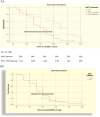Optimal medical therapy, clinical outcome and its predictors in patients with acute coronary syndrome after discharge with secondary prevention medications at University of Gondar Comprehensive Specialized Hospital, North West Ethiopia, 2023: A retrospective follow-up study
- PMID: 39363265
- PMCID: PMC11448055
- DOI: 10.1186/s12872-024-04199-x
Optimal medical therapy, clinical outcome and its predictors in patients with acute coronary syndrome after discharge with secondary prevention medications at University of Gondar Comprehensive Specialized Hospital, North West Ethiopia, 2023: A retrospective follow-up study
Abstract
Background: The life-threatening diseases known as ACS (acute coronary syndrome) continue to produce considerable rates of morbidity and mortality despite breakthroughs in therapy. The study determined clinical outcome and its predictors in patients at the University of Gondar Comprehensive and Specialized Hospital (UOGCSH), North West Ethiopia.
Design, setting, and participants: A retrospective cohort study design was employed at UOGCSH from January 31, 2018 to February 1, 2023. The hospital used a systematic random sampling procedure to select study participants from the medical records of patients in chronic cardiac follow-up clinics.
Main outcome measures: Exposures were optimal medical therapy (OMT) versus non-optimal medical therapy collected from May to August 2023. Descriptive and analytical statistics were employed to compare study groups. A binary logistic regression model was employed to identify candidate variables for further analysis. Cox's proportional hazard model and log-rank test were employed, with a P-value < 0.05 used to evaluate statistical significance. A five-year all-cause mortality after discharge estimate was displayed by using Kaplan-Meier curves.
Results: Among 422 patients with ACS [mean age, 61.56 (SD = 9.686) years; 54.7% male], of whom only 59.2% (250) received optimal medical therapy at discharge. Age ≥ 65, atrial fibrillation, chronic kidney diseases, and cardiogenic shock were negative independent predictors of optimal medical therapy. On the other hand, male sex was independently associated with the use of optimal medical therapy. All-cause mortality occurred in 16.6% (n = 70) and major adverse cardiac events occurred in 30.8% (n = 130) of patients with a 95% CI of 0.132-0.205 and 0.264-0.355, respectively. Multivariate analyses indicated that OMT was significantly associated with reduced all-cause mortality (aHR: 0.431, 95% CI: 0.222-0.835; P = 0.013).
Conclusion: This study revealed that the use of preventive OMT in patients discharged with acute coronary syndrome was associated with a reduction in all-cause mortality. However, the use of this OMT is suboptimal.
Keywords: Acute coronary syndrome; Clinical outcome; Ethiopia; Gondar; Optimal medical therapy.
© 2024. The Author(s).
Conflict of interest statement
The authors declare no competing interests.
Figures



Similar articles
-
Trends in optimal medical therapy at discharge and clinical outcomes in patients with acute coronary syndrome in Thailand.J Cardiol. 2021 Jun;77(6):669-676. doi: 10.1016/j.jjcc.2020.12.015. Epub 2021 Jan 15. J Cardiol. 2021. PMID: 33455848
-
Treatment outcome of acute coronary syndrome patients admitted to Ayder Comprehensive Specialized Hospital, Mekelle, Ethiopia; A retrospective cross-sectional study.PLoS One. 2020 Feb 13;15(2):e0228953. doi: 10.1371/journal.pone.0228953. eCollection 2020. PLoS One. 2020. PMID: 32053702 Free PMC article.
-
Management quality indicators and in-hospital mortality among acute coronary syndrome patients admitted to tertiary hospitals in Ethiopia: prospective observational study.BMC Emerg Med. 2021 Mar 31;21(1):41. doi: 10.1186/s12873-021-00433-3. BMC Emerg Med. 2021. PMID: 33789565 Free PMC article.
-
Optimal medical therapy vs. coronary revascularization for patients presenting with chronic total occlusion: A meta-analysis of randomized controlled trials and propensity score adjusted studies.Catheter Cardiovasc Interv. 2019 May 1;93(6):E320-E325. doi: 10.1002/ccd.28037. Epub 2018 Dec 13. Catheter Cardiovasc Interv. 2019. PMID: 30549199
-
Incidence and predictors of opportunistic infections in adolescents and adults after the initiation of antiretroviral therapy: A 10-year retrospective cohort study in Ethiopia.Front Public Health. 2022 Dec 15;10:1064859. doi: 10.3389/fpubh.2022.1064859. eCollection 2022. Front Public Health. 2022. PMID: 36589962 Free PMC article. Review.
References
-
- Cheema KM, et al. Long-term trends in the epidemiology of cardiovascular diseases in the UK: insights from the British Heart Foundation statistical compendium. Cardiovasc Res. 2022;118(10):2267–80. - PubMed
-
- Boden WE, et al. Contemporary approach to the diagnosis and management of non–ST-Segment elevation acute coronary syndromes. Prog Cardiovasc Dis. 2008;50(5):311–51. - PubMed
-
- Bhatt DL, Lopes RD, Harrington RA. Diagnosis and treatment of acute coronary syndromes: a review. JAMA. 2022;327(7):662–75. - PubMed
MeSH terms
Substances
LinkOut - more resources
Full Text Sources

